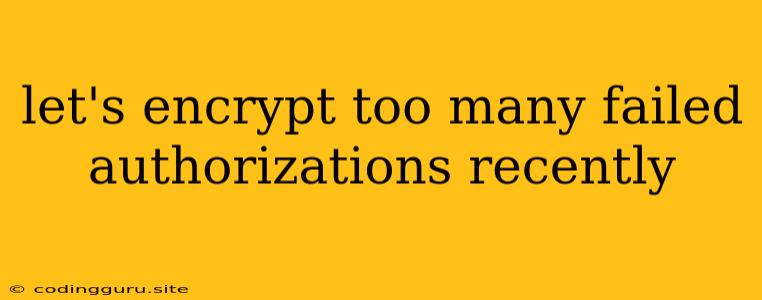Let's Encrypt: Dealing with "Too Many Failed Authorizations Recently"
Let's Encrypt is a fantastic tool for securing websites with free SSL certificates. However, you might encounter the error "Too many failed authorizations recently" when attempting to obtain a new certificate. This message indicates that Let's Encrypt has detected a high number of failed authorization attempts from your server, possibly due to various reasons.
Understanding the Error
Let's Encrypt uses automated challenges to verify that you control the domain you are requesting a certificate for. These challenges typically involve placing a specific file or modifying a DNS record on your server. If these challenges repeatedly fail, Let's Encrypt might temporarily block your account to prevent abuse and maintain the security of its services.
Common Causes for Failed Authorizations
1. Incorrect Configuration:
- Misconfigured DNS records: If your DNS records don't point correctly to your web server, Let's Encrypt cannot verify your control over the domain, leading to failed authorizations.
- Firewall blocking port 80 or 443: Let's Encrypt uses these ports to communicate with your server during the authorization process. Ensure your firewall is configured to allow access on these ports.
- Incorrect web server configuration: Misconfigured virtual host settings or incorrect document root paths can also cause challenges to fail.
- Missing or incorrect SSL/TLS certificates: If you already have an SSL certificate installed, ensure it is properly configured and doesn't conflict with Let's Encrypt's validation process.
2. Security Measures:
- Rate limiting or intrusion detection systems: Some security measures might block Let's Encrypt's validation requests, mistaking them for malicious activity.
- Anti-malware or antivirus software: Certain antivirus or anti-malware software may interfere with the validation process.
3. Domain Issues:
- Domain ownership changes: If you recently changed the ownership of your domain, Let's Encrypt might need some time to update its records.
- Domain registrar issues: Sometimes, issues with your domain registrar can affect the validation process.
Troubleshooting Steps
1. Review Your Configuration:
- DNS Records: Carefully check your DNS records and ensure they are correctly pointing to your webserver.
- Firewall: Verify that your firewall allows access on ports 80 and 443 for Let's Encrypt's validation requests.
- Web Server Configuration: Examine your web server configuration files (e.g., Apache's .htaccess or Nginx's server blocks) for any potential errors that might be affecting validation.
- SSL/TLS Certificates: Check if you have any existing certificates and ensure they are properly configured and not conflicting with Let's Encrypt's validation process.
2. Check for Conflicts:
- Security Measures: Temporarily disable any rate-limiting or intrusion detection systems and see if that resolves the issue.
- Anti-malware/Antivirus: Check your anti-malware and antivirus settings to see if they are interfering with Let's Encrypt's validation requests.
3. Contact Your Domain Registrar:
- Domain Ownership Changes: If you recently changed domain ownership, inform your domain registrar and confirm that the change has been properly reflected in their records.
- Registrar Issues: Contact your registrar to inquire about any potential issues that might be impacting the validation process.
4. Use a Different Validation Method:
- DNS Validation: If the file-based validation (HTTP) is failing, try using the DNS-based validation method.
5. Wait It Out:
- Temporary Block: If Let's Encrypt has temporarily blocked your account due to too many failed authorizations, wait for a short period before retrying.
Tips for Preventing Failed Authorizations
- Regularly Check Your Configuration: Periodically review your server's configuration to ensure it is up-to-date and error-free.
- Test Your Configuration: Before requesting a certificate, test your validation setup by simulating the Let's Encrypt challenge.
- Use a Reliable DNS Provider: Choose a reputable and reliable DNS provider to minimize the risk of DNS record issues.
- Update Security Measures: Keep your firewall, anti-malware, and other security measures updated to prevent conflicts with Let's Encrypt's validation process.
- Use a Trusted Certificate Authority: Stick to trusted certificate authorities like Let's Encrypt to ensure the security and validity of your certificates.
Example:
If you are encountering the "Too many failed authorizations recently" error while using Let's Encrypt, check your website's configuration, especially your DNS records and web server settings. Make sure the firewall allows access on ports 80 and 443 for Let's Encrypt's validation requests.
Conclusion
The "Too many failed authorizations recently" error message from Let's Encrypt usually indicates problems with your server configuration, security settings, or domain ownership. By carefully reviewing and troubleshooting these areas, you can successfully obtain a Let's Encrypt certificate for your website. Remember to always prioritize security and follow best practices to avoid future issues.
